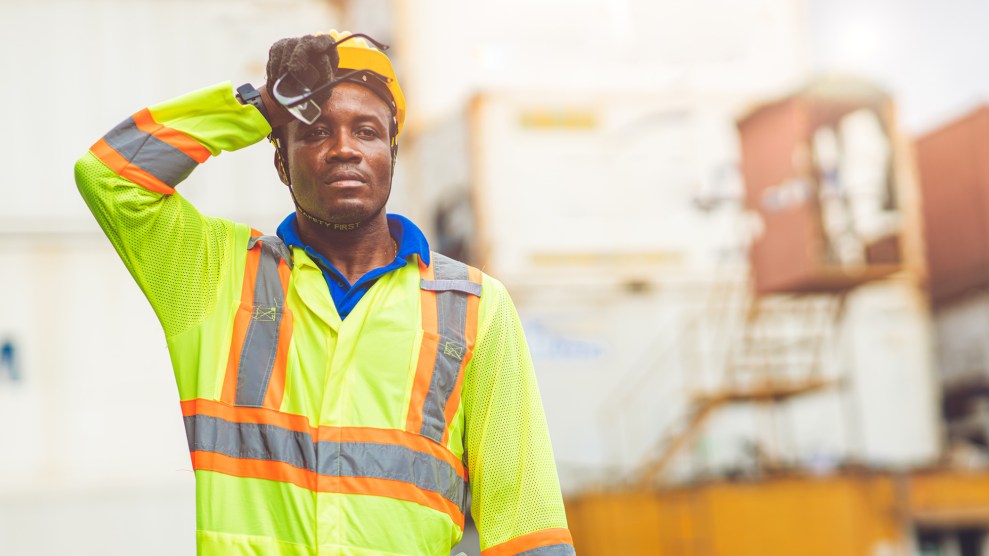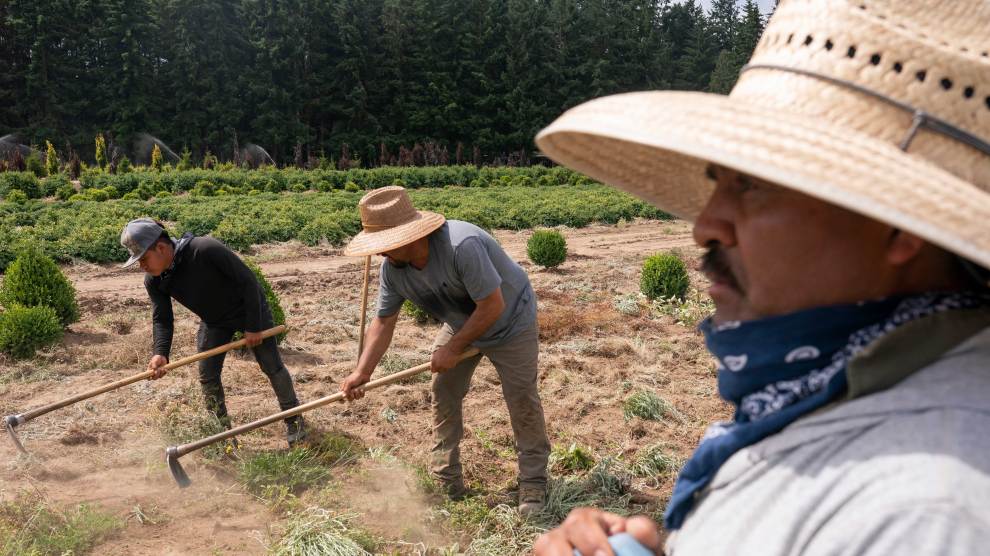
Jon G. Fuller/Zuma
This story was originally published by the Guardian and is reproduced here as part of the Climate Desk collaboration.
Big-business lobbyists, including big agricultural and construction groups, are pushing to water down or stymie efforts at the federal and state levels to implement workplace heat protection standards.
This summer, millions in the United States have been exposed to some of the hottest days on record, inciting renewed urgency for federal protections from heat exposure for US workers. The Biden administration has proposed such protections. But those rules face stiff opposition and could take several years to be finalized under current rule-making processes and laws. They could even be scrapped, depending on the outcome of 2024’s election.
Business groups and lobbyists have aggressively opposed efforts at state and federal levels to enact heat protection standards for workers, claiming employers already practice what a standard would mandate, expressing concerns about the burden on employers, and claiming the efforts take a “wrong approach.”
Between 2011 and 2021, 436 workers died from heat exposure according to the Bureau of Labor Statistics, but that is most likely an undercount because heat-related deaths are often attributed to other accidents or health conditions.
At present, no federal law protects workers specifically from extreme heat. Farm workers and advocacy groups are also pushing to include heat protections for farm workers in the 2023 farm bill currently being considered by Congress. But with Republicans in control of Congress, such a measure is unlikely to pass.
In September 2021, the Biden administration announced the launch of a rule-making effort at the Occupational Safety and Health Administration to develop heat exposure standards to protect outdoor and indoor workers.
The powerful American Farm Bureau Federation has objected to the proposal. “Considering the variances in agricultural work and climate, AFBF questions whether the department can develop additional heat illness regulations without imposing new, onerous burdens on farmers and ranchers that will lead to economic losses,” it said in its comments on the rule.
The group has a long history of denying science around the climate crisis and has teamed up with fossil fuel interests in fights over climate policies.
The Construction Industry Safety Coalition said while it “appreciates OSHA’s rule-making in this area,” its members have “significant concerns with any regulatory approach that imposes complicated requirements on contractors and requirements that are triggered by threshold temperatures that are common in wide swaths of the country for much of the year.”
The National Demolition Association, a construction business group, said in its opposition “issues of heat exposure and the means to address it on the variety of construction worksites across the country are extremely complex.” The proposed rule “essentially dictates how and what should be included in an OSHA standard for heat exposure, [and] does not account for the complexities of the issue.”
A handful of states, California, Colorado, Washington, Oregon, and Minnesota, have issued their own heat exposure standards. Oregon is the only state also to protect indoor workers from heat exposure. Business groups have responded with lawsuits in Oregon and industry groups have already questioned the feasibility of a federal heat illness standard.
Meanwhile, the Texas governor, Greg Abbott, has rescinded city ordinances that mandated heat protections for workers. The move was applauded by business groups.
Last week Biden announced new measures to tackle the heat crisis, including hazard alerts for workplaces such as farms and construction sites. Experts described the announcement as positive but modest. In the meantime, his efforts to implement federal heat protections are making slow progress.
The OSHA rule-making process comprises seven stages. On average it takes OSHA a over seven years to develop and issue safety and health standards, according to a report by the Government Accountability Office. And it can take significantly longer. An OSHA standard on silica exposure finalized in 2016 took 45 years to implement. The agency estimated it would have prevented 1,600 new cases of silicosis annually and saved more than 600 lives a year.
“It’s going to be many, many years before we see a final standard, because there’s so many steps the agency has to go through, and they have to collect so much data and so much information more than other agencies when they do something similar,” said Debbie Berkowitz, who served as chief of staff and senior policy adviser at OSHA during the Obama administration.
“It’s not rocket science to protect workers from heat. Many employers do it but many employers don’t. It’s not that expensive,” Berkowitz said. “But it’s good to have a standard, a standard will really save lives.”
Berkowitz said that protection standards for workers should include water, rest breaks, access to shade, acclimatization for workers exposed to excessive heat on the job, and training for workers and managers on heat protections and the symptoms of heat illnesses. While at OSHA, she noted, several investigations into heat-related worker deaths involved workers who had just started working in intense heat on the job. For example, in July 2022, 24-year-old Kaylen Gehrke died on the job from heat stroke in Louisiana on her first day conducting archaeological surveys outdoors while the area was under a heat advisory warning.
“The workers most impacted are the ones who bring us our food, build our buildings, it seems to me a no-brainer to give Osha the authority to move quickly to require these basics, that employers require water, that they educate workers on the early symptoms of heat stress that if not attended to can lead to fatalities quickly,” Berkowitz added. “I think most farm workers and other workers that go and toil in the sun every day deserve our gratitude and our thanks and deserve this protection.”
At least two Florida farm workers have died this year due to heat exposure, 29-year-old Efraín López García died on July 5 and another unnamed farm worker died in Parkland in January on their first day on the job. The state legislature declined to consider a bill to enact heat exposure protections for workers, though the protections would not have been enforceable. Miami-Dade county recently introduced a bill in the county commission to enact heat standards locally.
Dr Nezahualcoyotl Xiuhtecutli, general coordinator of the Farmworker Association of Florida, explained farm workers are even more susceptible to heat exposure due to the piece rate system, where workers are paid based upon the number of units of crops they pick.
“The piece rate system makes it even more difficult because they feel pressure to work harder and pick more so they can actually increase their salary, but this disincentivizes them from taking breaks and paying attention to their body because they’re thinking about how it’s going to affect their income,” said Xiuhtecutli.
He expressed disappointment that the Florida legislature didn’t consider a bill to implement heat protections for workers and argued the onus shouldn’t be on workers themselves to protect themselves from excessive heat.
“These deaths are preventable,” he said. “We have guidelines for how to prevent them. Neglecting to take care of them just really speaks volumes about our priorities as a society and as a state, because we can’t even take care of the lives of our most vulnerable workers.”
With recent extreme heatwaves, anticipation of a new normal of record-setting temperatures due to the climate crisis, and ongoing reported cases of workers dying on the job due to heat exposure, worker advocacy groups, unions and elected officials are increasing pressure for heat exposure standards to be implemented at local, state and federal level.
On July 25, Congressman Greg Casar of Texas began a thirst strike at the US Capitol with the labor activist Dolores Huerta, calling on OSHA to implement federal heat standards to protect workers, including water breaks. Some 112 members of Congress signed a letter on July 24 calling on OSHA to implement heat protection standards for workers, basing standards on a proposed congressional bill, the Asuncion Valdivia Heat Illness and Fatalities Prevention Act, named after a farm worker who died from heat exposure in 2004.
The bill was reintroduced to Congress on July 26. Congress has previously passed legislation ordering OSHA to expedite safety standards, such as the Needlestick Safety and Prevention Act passed in 2020 that mandated OSHA update worker safety standards on blood-borne pathogens.
“It’s a commonsense piece of legislation that will require employers to provide workers with what are quite frankly, humane work conditions in the face of extreme heat,” said Dr Rachel Licker, a principal climate scientist at the Union of Concerned Scientists and co-author of a 2021 report on the threat climate change poses to workers. “We know that there’s already extreme heat happening around the world at levels that are dangerous for outdoor workers and the story is just going to get worse as the world warms because of climate change and emissions from fossil fuels, so it’s clearer than ever that we need to be better prepared because workers are getting injured and dying on the job because of this hazard.”
In a statement, OSHA’s assistant secretary, Doug Parker, said that as the agency is working on issuing a final rule on heat illness prevention, it is ramping up enforcement compliance efforts and outreach efforts.
“Many workers are at increased risk, sometimes because of the jobs they do, but also because of factors like the color of their skin, their ethnicity, or the fact that English is not their first language,” said Parker. “Every worker is entitled to a safe and healthy workplace, and we will continue to use all the tools in our toolbox to ensure all workers have the health and safety protections they need and deserve in every workplace.”












